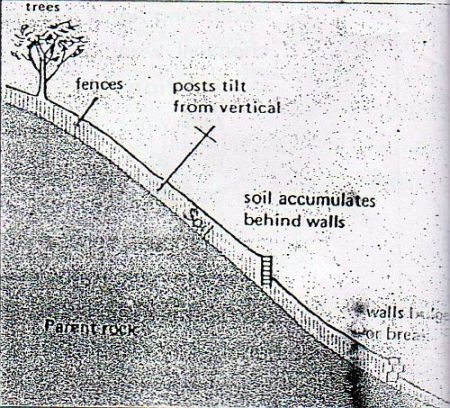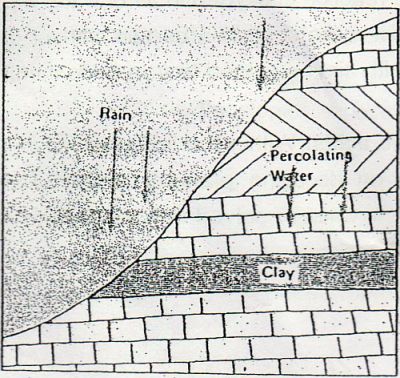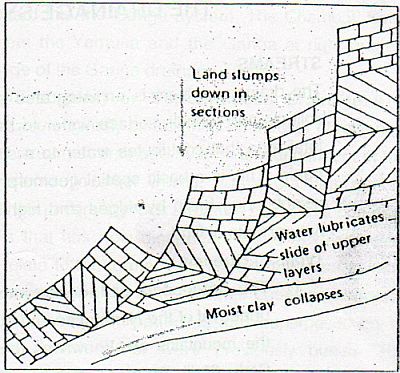(World Geography) Weathering and Mass Movement & Wasting, Types, Erosion, Transportation and Deposition
WORLD GEOGRAPHY
Concepts of Geography, Natural Resources
WEATHERING AND MASS MOVEMENT
The process of wearing away the earth causes a general lowering and levelling out of the surface. It is known as denudation and is carried out in four phases-
-
Weathering
-
Erosion
-
Transportation
-
Deposition
WEATHERING: Factors Influencing Weathering Processes
Types and rates of weathering vary, at the regional and local spatial scales. In addition to climate, the type of rock (lithology) and the nature and amount of fractures or other weaknesses in it are major influences on the effectiveness of the various rock weathering processes.
1. Climate : Different climatic conditions are associated with different weathering processes. Example, chemical weathering, is particularly effective and rapid in humid climates. Chemical weathering is much more restricted in arid climates. Arid regions typically receive sufficient moisture for physical weathering by salt crystal growth and the hydration of salts. Abundant salts, high humidity, and contact with seawater make salt weathering processes very effective in marine coastal location.
2. Rock Type : Weathering is greatly influenced by the character of the bedrock: hard or soft, soluble or insoluble, broken or unbroken. Areas of diverse rock types undergo differential weathering and erosion; easily eroded rocks exhibit more extensive effects of weathering and erosion than the resistant rocks.
3. Slope orientation : The geographic orientation of a shop- whether it faces north, south east, or west- controls the slope’s exposure to sun, wind, and precipitation.
4. Vegetation : Although vegetative cover can protect rock by shielding if from raindrop impact and providing roots to stabilize soil, it also produces organic acids from the partial decay of organic matter; these acids contribute to chemical weathering. Plant roots can enter crevices and break up a rock, exerting enough pressure to force rock segments apart, thereby exposing greater surface area to other weathering processes. In the complexity of nature, physical and chemical weathering processes usually operate together. Of course, in all of this, is the crucial factor, for these processes require long periods of time to operate.
Types of Weathering
1. Chemical weathering : Air and water contain chemical elements, which though they may be in small quantities, are sufficient to set up chemical reactions in the surface layers of exposed rocks. Such reactions may weaken or entirely dissolved certain constituent of the rock, thus loosening the other crystals and weakening the whole surface.
When a soil convers exists chemical weathering of the underlying rocks does not cease; on the contrary it is usually enhanced. This is because the soil absorbs rain-water and keeps the underlying rocks in contact with this moisture. The rain-water absorbs organic acids from the soil and thus becomes a stronger weathering agent then pure rain-water acting on bare rock. There are three major chemical, weathering processes.
(a) Solution: Many minerals are dissolved by water, especially when, as with rain-water, it contains enough carbon dioxide to make it weak acid. The rate at which solution taken place is affected not only by the mineral composition of the rock but also by its structure, sedimentary rocks often have pore- spaces between the grains in which air and water can lodge and thus attack the rock. Rates of weathering are also affected climate warm wet climates promote rapid chemical weather. While dry climate inhibit chemical weathering. Dry climates, however, provide good conditions for physical or mechanical weathering.
(b) Oxidation: Oxidation is the reaction of oxygen in air or water with minerals in the rock. For example, most rocks contain a certain amount of iron, which when it comes in contact with air is changed to iron oxide, familiar brownish crust or rust.
(c) Decomposition by organic acids: Within the soil which covers most rocks are bacteria which thrive on decaying plant or animal material. These bacteria produce acids which, when dissolved in water, help to speed up the weathering of the underlying rocks.
2. Physical or mechanical weathering.: Mechanical weathering is the physical disintegration of a rock by the actual prising apart of separate particles. It takes place in a number of ways.
(a) Repeated temperature change: In deserts, rocks exposed to the blazing sun during the day are intensely heated. The outer layers expand much faster than the cooler interiors of the rock and tend to pull away from the rest. At night fall the temperature drops rapidly and the outer layers contract more rapidly than the interior, setting up internal stresses. Such stresses, repeated for a long time causes the rock to crack and split.
(b) Frost Action: It the water enters the cracks of the rocks and freezes the cracks widen due to expansion of water.
3. Biotic Weathering : Biotic weathering involves faunal weathering by animals or floral weathering by plants. But recently ‘economic and technological man’s has become one of the biggest agents of weathering. Anthropogenic activities involve agriculture, construction, transport, industrialization, urbanization etc.
MASS WASTING / MASS MOVEMENT : Mass movement is the movement of weathered material down a slope due to gravitational forces.
1. Soil Creep: This is a slow, gradual but more or less continuous movement of soil down the hill slopes. It is shown on the figure to the right.

2. Soil Flow ( Solifluction ) : When the soil is completely saturated with water the individual particles are almost suspended in the water and move easily over one another and over the underlying rock. The soils acts like a liquid and a soil-flow or mud-flow occurs. In temperature and tundra regions soil flow occur when the surface layers of frozen ground than in spring. In Ireland such flows are known as ‘bog-bursts’.

3. Landslides (slumping or sliding) : There are very rapid kinds of
movement and occur when a large mass of soil or rock falls suddenly. Land-slides
usually occur on steep slopes undercut by a river or the sea so that it falls by
gravity. Slumping is particularly common where permeable debris or rock layers
overlie impermeable strata such as clay. Water sinking through the permeable
material is halted by the clay. The damp clay provides a smooth slippery surface
over which the upper layers easily slide.

data-matched-content-ui-type="image_card_stacked"
Useful Tips & Articles
तैयारी कैसे करें? |
EXAM SUBJECTS |
STUDY RESOURCESDownload Free eBooks |


